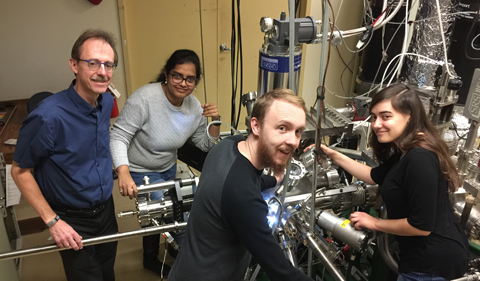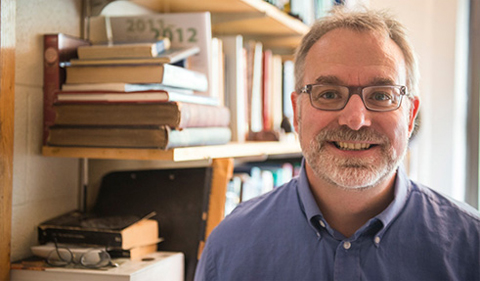
Dr. Arthur Smith with graduate students Sneha Upadhyay, Joseph Perry Corbett, and undergraduate Alexandra Semposki
Amid several conferences, pending proposals and graduating students from his laboratory, Nanoscale & Quantum Phenomena Institute member and Physics & Astronomy Professor Dr. Arthur Smith has had quite the sabbatical exploring spintronic research.
With the help of his current graduate students Sneha Upadhyay , Joseph Perry Corbett, and undergraduate Alexandra Semposki, Smith explores new ways to improve their study in one of two labs he maintains.
“It’s been a big advantage to be over here in this lab to get a hands-on approach with this equipment,” Smith said. “The idea is to take the lab from where it was to a better position.”
Spintronics is a discipline that seeks to further understand the electron spin state and its associated magnetic properties. It differs from electronics such that spins are explored as independent motions in addition to the electron’s charge state.
While some spintronic research groups tackle the currents created by spin, Smith’s team looks to create alternative forms of two materials that can generate the spin currents themselves: ferromagnets and antiferromagnets.
Although these two materials constitute the same principle of ordered magnetism, there is a crucial difference between them; neighboring electrons within antiferromagnetic lattices have anti-parallel spin orientations (i.e. when placed in a row, the spin order is: up-down-up-down, and so on). Likewise, ferromagnets are composed of all parallel orientations (i.e. all up, or all down).
In terms of applicability, spintronic devices can store information using these different spin orientations and orderings – akin to binary zeroes and ones. Since the spins are components of electrons moving along a current, information can move through a wire and be stored at an output.
When placed together sequentially, ferromagnets and antiferromagnets are responsible for exchange biases, a phenomenon commonly seen in magnetic rewriting of disk drive technologies in computers.
The Smith team aims to further understand the applicability of different ferromagnetic and antiferromagnetic materials.
“What we’re trying to do is basically use spin as an additional variable or parameter one could hope to utilize in some future application,” Smith said. “There’s still a lot of interest in trying to better understand how these materials work.”



















Comments